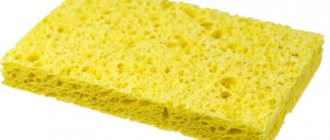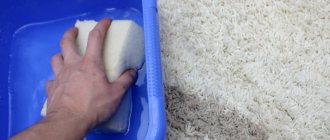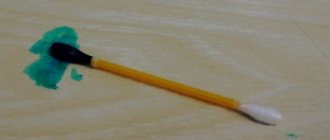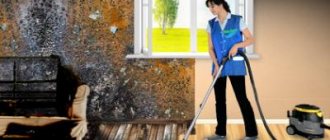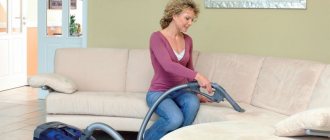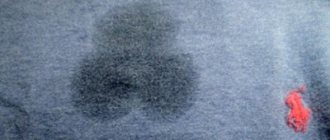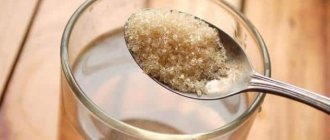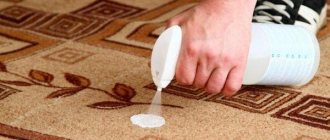Main problems with lacquered furniture
Such home furnishings acquire their characteristic shine due to the fact that during the production process the wood is coated with special compounds containing resins and varnishes.
Due to these features, furniture:
- quickly absorbs various contaminants;
- prone to the formation of microcracks and chips;
- accumulates static electricity, which attracts dust.
Polished furniture has strict maintenance requirements. Such items should not be placed in rooms with high humidity levels or in places exposed to direct sunlight.
Lacquered surfaces do not tolerate temperature changes and exposure to abrasive particles. In both cases, cracks appear.
After cleaning the varnished surface with a damp cloth, stains remain, and the dry material electrifies the material, thereby facilitating the settling of dust.
Why are scratches dangerous?
There are many reasons in everyday life that cause the formation of scratches. Deep and superficial, large and small, chips and dents, all of them negatively affect the condition of the furniture. And the point is not even a deterioration in appearance, but rather a reduction in the service life.
A scratch is damage to the surface layer, which quickly renders the furniture unusable. If we talk about inexpensive interior elements, the slightest damage to the protective layer provokes the release of harmful toxic substances into the air of the living space.
Moisture quickly penetrates into the recesses on the surface, lingers there and provokes a change in the strength and integrity of the furniture. Therefore, it is important to promptly remove all damage in order to preserve and increase the service life of the headset.
What might you need?
You can clean varnished surfaces using:
- soft cloth;
- cotton swabs;
- leather (it is recommended to take soft and thin skin);
- a brush with soft bristles.
See also
Where do insects come from in an apartment and how to get rid of them, means and methods of control
To clean polished home furnishings, you will need not only cleaning products, but also a knife to remove serious stains.
Soft flannel or cotton cloth
Flannel and cotton fabric practically do not electrify varnished wood and do not leave streaks. Therefore, it is often recommended to wipe furniture with this material.
Cotton swabs
Cotton wool is used to clean stubborn stains.
Pieces of soft leather
Soft leather is recommended to be used to add shine after cleaning from dirt.
Soft brush
This brush is used to remove stubborn stains. After polishing with such products, no scratches remain.
Water containers
When cleaning furniture, you will need any containers with a wide neck: buckets, pans, or others.
Knife for removing serious stains
The knife is used only in cases where other cleaning methods have failed.
What materials can be polished?
As a rule, furniture coating is a varnish layer of one composition or another. In Soviet times, the main type of coating was polyester varnish. It was applied in a thick layer (0.5-0.8 mm), ground and polished on special production lines.
Modern furniture has a varnish coating made on the basis of the same polyester. Or other materials. there are many of them, but the general properties are approximately the same.
The most common coatings are:
- polyester;
- polyurethane;
- nitrocellulose;
- impregnation with oil of natural or synthetic origin.
Almost all varieties can be polished. The softer the varnish, the easier it is to polish, but its abrasion resistance is much lower.
Paints and varnishes that are sold in retail chains are of little use for creating high-quality furniture coatings. They do not meet standards for hardness and load resistance. For restoring furniture coverings, they are suitable only in certain cases and require proper use.
Cleaning methods at home
To remove stains from a varnished surface, household chemicals and folk remedies are used. The latter often allow you to achieve a more pronounced effect.
Beer
To remove traces of dirt, you will need to mix malt beer and wax. This composition must be boiled to remove the alcohol.
Then you can rub the furniture with the resulting solution. Beer can remove various types of dirt, and wax will return the varnished surface to its original color.
Special solution
A mixture of shampoo, water and antistatic agent, taken in equal proportions, helps to remove stubborn dirt and grease from polished furniture with your own hands. The latter prevents dust from settling on the surface.
Olive oil and wine vinegar
To clean furniture, you need to mix both components in equal proportions and wash the varnished surface. Wine vinegar can cope with various types of stains. At the same time, the liquid disinfects the surface being treated. Olive oil is used to restore shine.
Burr oil
To remove dirty stains, just apply this oil to problem areas and after 5-7 minutes wipe the surface with a dry material.
Tea brewing
Welding is used both to remove dirt and to strengthen polished wood.
See also
17 best remedies for fungus and mold on walls with descriptions
Turpentine, vinegar and flax oil
You can clean contaminated furniture with a mixture of 50 milliliters of linseed oil and turpentine with the addition of 25 milliliters of vinegar essence. In this composition you need to dip a piece of cotton wool and quickly wipe the problem areas.
Sauerkraut brine
To get rid of traces of dirt, just soak a piece of cloth in an acidic solution of sauerkraut and rinse the problem areas, and then clean the surface with a dry cloth. After this procedure, you should also treat the furniture with flannel.
Effective polishes
The use of polishes eliminates the need to prepare cleaning compounds. In addition, cleaning furniture with household chemicals reduces the likelihood of scratches or other defects resulting from poor proportions.
Pronto
This polish is one of the most popular. Simply apply the product to the problem surface and wipe with a dry cloth.
Chirton
Also refers to popular polishes. Chiron contains wax, thanks to which, after treatment, the surface restores its former shine.
Emsal
Emsal has a soft effect on the processed material and hides minor scratches. The polish does not contain wax or silicone.
Luxus
Luxus does not dry out the surface of lacquered furniture, and after treatment creates an additional protective layer.
Mebelux
In terms of the effect it has on polished furniture, Mebelux is no different from Luxus.
Cinderella
A popular Russian polish that removes traces of grease and dirt, while simultaneously removing static electricity.
Fabulous furniture
The polish contains carnauba wax, which masks small cracks and restores shine.
How to clean wooden furniture. HOW to easily clean KITCHEN FURNITURE from greasy deposits
Grease stains on kitchen surfaces are normal. During cooking, they can end up in the most unexpected places. Sometimes you even have to wash the ceiling.
But you can’t use the first product that catches your eye.
It is important to consider what material the surfaces are made from so as not to harm their appearance.
Cleaning your kitchen of grease is very easy if you do it right.
As a rule, the parts closest to the cooking area suffer the most from fat. And this role is always occupied by kitchen furniture. It is made from several popular materials, each of which has its own characteristics. It is worth considering kitchens made of MDF, wood and plastic.
How to work with MDF
MDF kitchens are distinguished by the beautiful and durable material from which the surfaces are made. They require a thorough approach to cleaning, as they can be easily damaged. There are three ways to wash them from fat.
Mustard
A specially hand-prepared paste will allow you to wash away old grease from your favorite kitchen furniture. This method can also be used for household appliances and stone coatings.
How to achieve the result:
Mix some mustard powder with water to form a thick mass. Apply it to all problem areas for a few minutes.
Carefully remove any residue with a soft cloth soaked in warm water.
All the fat will remain on the rag. Therefore, you should only take fabric that can be thrown away.
Ammonia
A popular means of getting rid of contaminants since ancient times is ammonia. It can have a negative effect on some materials, but in this case it is harmless.
What to do:
- Dilute a liter of water with a spoon of ammonia.
- Fill a spray bottle with them.
- Spray onto all stained areas.
- Blot with a dry cloth.
This method cannot be used to clean a glossy kitchen, as this may cause unsightly liquid marks to form.
Alcohol, vinegar, lemon
An ideal option for modular kitchens with glossy finishes, which will suit the white color. It will not harm even low-quality materials, making it an almost universal means of removing dirt on kitchen cabinets and other surfaces.
How to proceed:
- Mix equal parts of vinegar, alcohol and lemon juice or grated zest.
- Blot with a soft cloth and wash off all dirty marks.
- Wipe with a clean cloth.
How and with what to clean a wooden kitchen
Cleaning a kitchen made of wood is no more difficult than any other. You just need to use certain tools that are suitable specifically for it.
Oil, soda
The combination of vegetable oil and baking soda does an excellent job of removing various stains, ridding the kitchen of plaque or other contaminants.
How to wash:
Mix the oil in a ratio of 1 to 2, distribute, treat with a sponge without hard lint and then rinse.
If cleaning a wooden kitchen with such actions does not work the first time, you can repeat it. Also, instead of this mixture, you can use lemon slices, which you need to wipe all the necessary places and wait ten minutes before rinsing.
Baking powder for the dough
Baking powder, known to all chefs, instantly cleans countertops and other furniture. You will need a volume of powder that is enough to cover all dirty spots.
Application:
Dilute the powder slightly with water to obtain a thick paste.
Cleaning complex contaminants
Folk remedies also help to cope with difficult stains. In particular, to clean surfaces, you can sprinkle problem areas with flour and then wipe with vegetable oil.
Traces from hot dishes
To remove such marks, just put a small amount of salt in a cloth, roll up the bag and wipe the furniture. Then the surface must be treated with vegetable oil.
Wax drops
To get rid of the wax, you need to heat the knife and pry out the drops. After this, the problem area is rubbed with gasoline.
See also
30 best remedies for getting rid of mold under wallpaper
Ink stains
A mixture of beer and wax helps get rid of ink stains. This composition does not need to be boiled first. After treating stains, the mixture should be immediately washed off with water.
Heavy soiling
Heated 9% vinegar can remove such stains. You need to moisten a cotton swab in this liquid and then wipe the problem area.
Cleaning away traces of flies
White wine helps with such traces without adding other ingredients.
Unknown origin
To remove any stains, you can use vegetable oil, which should be mixed with ethyl alcohol.
Fat
Traces of fat can be easily removed with leftover tea leaves wrapped in cotton cloth.
How to use polish correctly?
Before starting work, all furniture is cleaned of dust and dirt. The polish is applied only to a dry surface. If you have an aerosol, then spray it while holding the can thirty centimeters from the furniture. The product in the form of a cream is squeezed onto a dry sponge and then rubbed into the surface.
To maintain the effect, various surfaces need to be polished at regular intervals. It is advisable to treat the countertop at least once a week. But for cabinets, once a month will be enough.
Dealing with minor defects
Oil-based products or stains can help remove scratches. But such compositions are not recommended for use in cases where small cracks have appeared on the surface. To remove such defects, use wax, shoe polish or walnut.
Wax crayon
To hide a scratch, you need to melt wax in a water bath and treat the problem areas with the resulting composition, wiping these areas.
Shoe polish
Shoe polish must be matched to the tone of the surface being treated. The substances included in this product fill microcracks and thereby eliminate defects.
Walnut
Use the nut kernel to rub the problem areas with light pressure. The oil released during the procedure will fill the defects.
Types of polish
Polishes should be selected depending on the surface you plan to process. Wax polishes are intended for processing wooden furniture parts in order to give them shine and mask minor defects. The good thing about this product is that you don’t need to treat furniture with it often, it fits perfectly and lasts a long time. The main disadvantage of wax polish is that it is better not to touch the treated surface with your hands, as fingerprints will be very noticeable.
A polish designed to disguise scratches contains wax that fills in small indentations, making them less noticeable.
Polishes with a tinting effect contain a coloring pigment that masks defects and refreshes the color of furniture.
Polish intended for varnished surfaces. It, unlike other analogues with a universal composition, does not dry out furniture coated with varnish.
Pre-grinding
Polishing furniture is a long process and it begins with sanding. First, all cracks and other defects are covered with wood putty of a suitable color. After it has completely dried (the period is indicated on the label), sanding begins.
A sander is best for polishing wood or veneer. Tape or disk is a matter of taste and preference; it also depends on the complexity of the furniture shape. You will also need a set of sandpaper from coarse (80) to very fine (1200) grit.
In extreme cases, an angle grinder with a special attachment (disc and Velcro) may be suitable. But when working with it, it is difficult to achieve a really good result - there is no required mobility of the sanding platform, so the result of such wood polishing will not be above average.
What you might need to varnish furniture
We start sanding with 80 grit. We use it carefully, removing only large irregularities. Then we repeat the treatment with sandpaper at 120, then at 180 and 240. During the work, we must periodically remove dust and inspect the surface to identify unevenness and other defects. sometimes they are better identified by touch.
Then take water and 320 grit sandpaper. Wet the surface to be sanded and the sandpaper. We sand everything again, but this time with water. At this stage, you should get a good result - everything should be smooth. If everything is satisfactory, we move on; if not, we polish it for some more time.

